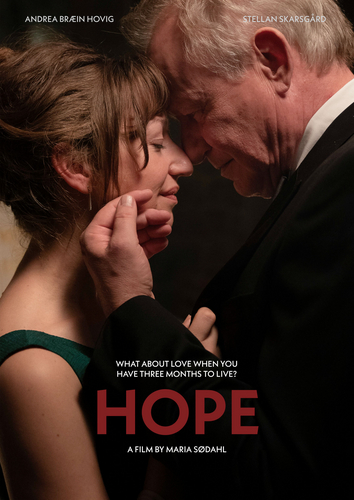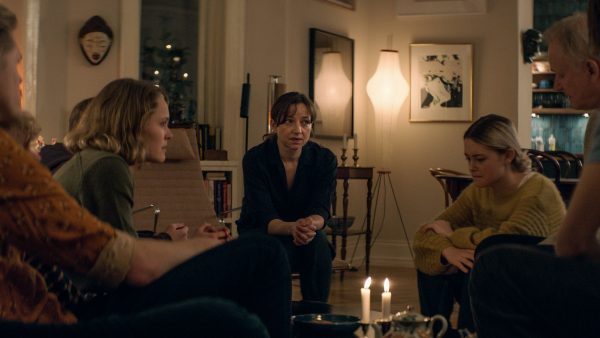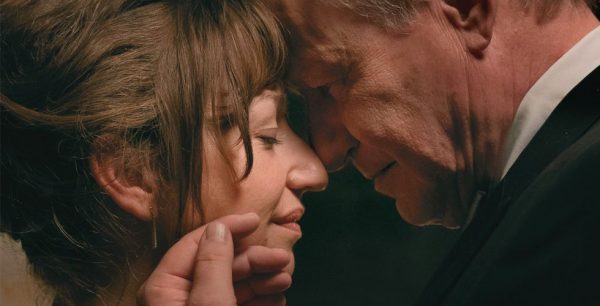‘Hope’ gives us courage in the face of despair
“Hope” (“Håp”) (2019 production, 2021 release). Cast: Andrea Bræin Hovig, Stellan Skarsgård, Elli Rhiannon Müller Osbourne, Daniel Storm Forthun Sandbye, Alfred Vatne Brean, Einar Økland, Steinar Klouman Hallert, Eirik Hallert, Dina Enoksen Elvehaug, Gjertrud L. Jynge, Alexander Mørk Eidem, Johannes Joner, Per Gørvell, Kristin Voss Hestvold, Hala Dakhil, Jacob Berg Thomassen. Director: Maria Sødahl. Screenplay: Maria Sødahl. Web site. Trailer.

When all seems lost, we’re left with little to hold onto. Whether we’re faced with dilemmas in romance, finances, vocation or health, we can easily become despondent when the problems appear overwhelming with no way out. At times like this, we have to grasp for anything that will help anchor us in the face of such despair, as seen in the new Norwegian domestic drama, “Hope” (“Håp”).
The holidays are supposed to be a time of hope, joy, and fellowship with family and friends. And most of us look to that time of year to see those aspirations fulfilled. However, when an unexpected crisis intrudes, it can send shockwaves through the celebration, affecting all involved. So it is for the blended family of long-time partners Anja (Andrea Bræin Hovig) and Tomas (Stellan Skarsgård).
When Anja begins having recurring headaches and vision problems, she visits her doctor (Kristin Voss Hestvold), who orders tests that, regrettably, come with a devastating diagnosis. From all indications, Anja appears to have developed a malignant, incurable brain tumor, one that metastasized from the lung cancer she was treated for (and thought cured) a year earlier. And, given her physician’s preliminary prognosis, she has little time left – not the kind of news one wants to receive at any time, but especially during the Christmas season.
Needless to say, Anja is distraught, as is Tomas, but not necessarily for the reasons one might think. Even though the couple has been together for many years and are bonded as the biological parents of three of the blended family’s six children (Elli Rhiannon Müller Osbourne, Daniel Storm Forthun Sandbye, Alfred Vatne Brean), a pronounced distance has been opening up between them for quite a long time. As a talented choreographer, Anja has established a noteworthy reputation for herself, having recently put on her first international production in Amsterdam. Tomas, meanwhile, has built a notable track record as a theatrical producer, with works staged all over Europe, a slate of projects that has kept him on the road and away from his native Oslo much of the time. Their careers have thus come first, leading to a marked detachment between them.
Given this growing separation between them, Anja can’t help but wonder how that will figure into the new crisis they now face. Will Tomas be there for her? What’s more, considering how things have been going, does she even want him there for her if his heart’s not in it? The last thing she wants to deal with is some semblance of forced, guilt-driven pity on his part.

Tomas, by contrast, realizes that he hasn’t always been as supportive as he could have been, letting work take precedence over his relationship. But now, as an awareness of what he’s about to lose sets in, he begins to feel a sense of regret, both for his failings as a devoted partner and for past infidelities. He thus sees this development as an opportunity to try and make up for oversights – that is, if she’ll let him. That’s perhaps most challenging when he suggests that they take the one step that they’ve been putting off during their time together – getting married.
Perhaps Anja’s biggest concern is how to broach the news of her illness with the family, especially during what is supposed to be the most festive time of the year. She wrestles with how to address the subject, torn between shielding the children’s feelings and being able to unburden herself of a secret that she has increasing difficulty containing. And, as much as she would rather not admit it, she also struggles with guilt over the varying degree of concern she holds for her own children compared to her three stepchildren from Tomas’s former marriage (Steinar Klouman Hallert, Eirik Hallert, Dina Enoksen Elvehaug). She clearly has a preference for comforting her own offspring, despite the undeniable care she feels for the others. How can she be expected to resolve circumstances like this with so much else that’s going on?
And then there’s her declining health, something she obviously can’t escape. She struggles with the side effects of her new medication (most notably insomnia and intense nervousness), her growing anxiety about the severity of her condition as the reality sinks in, and the inconsistent treatment she receives from a bureaucratic health care system that subjects her to ever more tests and sometimes leaves her in limbo as she awaits word on what comes next. This, combined with all of the other challenges she’s facing, leave her with a plate full of worry and uncertainty at a time when it’s unclear how much time she has left and what that time will be like. Under conditions like this, it’s hard to have any hope, but sometimes that’s all we’ve got.

Situations such as this are often characterized as being those where everyone involved hopes for the best but prepares for the worst. That can be a rather tall order to satisfy, given the disparate nature of the possible outcomes that could result. Accommodating such extremes calls for thinking outside the box, given that what could eventually happen goes beyond the range of expectations typically associated with most health-related matters. Indeed, extreme outcomes call for extreme measures to deal with them.
Devising the means for addressing these circumstances requires us to conceive such measures using all of the wherewithal at our disposal. But bringing them into being calls for more than just designing what we need; it also necessitates believing in the ability to do so. Such is the core concept behind the conscious creation process, the philosophy that maintains we draw upon our thoughts, beliefs and intents in manifesting the reality we experience and everything that goes into its composition. And, in an existence characterized by extreme conditions, as here, we often have to expand the range of resources we employ in materializing the measures for addressing them.
That’s where thinking outside the box comes into play in this scenario. It applies to everyone involved, too – the doctors providing care, Tomas as a compassionate and sincere caregiver, Anja as the patient seeking the means for healing her circumstances, and Anja’s family and friends as providers of loving support. What’s more, all of the potential survivors in this situation must prepare for what might happen if Anja should succumb to her illness, as the nature of their reality would be radically shifted in her absence. It would seem everyone has his or her work cut out for them.
This health care crisis is further complicated by the ancillary circumstances associated with it, namely, the emotional meltdown going on between Anja and Tomas. While that situation has been unfolding for some time, its severity has certainly been exacerbated by this latest development. The timetable for the couple achieving closure has suddenly drastically shrunk, and, if they hope to reach resolution, they’ll need to move fast – and at a time when their plates have suddenly been loaded up with much more than they’ve previously had to contend with. What’s more, the weight of emotions involved in this has also swelled dramatically in light of the magnitude of the circumstances now prevailing. In many ways, Anja and Tomas are being asked to multi-task their efforts at coming up with solutions for dealing with all of the various conditions they now face. Their requisite belief work is about to go into overdrive.

To their benefit, Anja and Tomas have ample support available to them. This truly is a co-creative endeavor, with each participant playing a vital role. By focusing their attention on the beliefs necessary to fulfill their respective obligations in this scenario, they have a greater chance of bringing into being what’s required to make this situation work out for the best. For example, the team of doctors (Per Gørvell, Hala Dakhil, Jacob Berg Thomassen) can play their part by devising the most efficacious treatment plan for their patient. Anja can best help her cause by plugging into beliefs related to healing, in all its forms, a lead that Tomas should follow, too. And the couple’s children, as well as good friends like Vera (Gjertrud L. Jynge), Arthur (Alexander Mørk Eidem) and Frans (Johannes Joner), can most effectively aid Anja by sending her warm, supportive vibes for her recovery. In collaborations like this, individuals might not always believe they’re making meaningful contributions, because their input might seem small and insignificant. However, when all of that input is combined, it creates a powerful force, one capable of working wonders greater than any of them can fathom by themselves. And that’s what fuels hope.
Still, even when armed with an optimistic outlook, the parties involved in a scenario like this must maintain a realistic perspective as well. Even if one is able to “fix” a dire situation, there’s no guarantee that the solution will be permanent. Of course, even if the repair is only fleeting, that’s still something to be proud of. Successes may flicker out of existence as quickly as the glimmer of a firefly, but they nevertheless embody the brilliance of creation, even if only temporarily. It’s in those momentary instances when we see the power of manifestation revealed, and that’s something we should never lose sight of. The point of power is in the present moment, and we must remember that, whether we’re seeking to create something as simple as an evening meal or as grand as a cure for a terminal illness. And that, too, should give us hope that what we seek can indeed be made possible, no matter how enduring or transitory it might be.

A crisis can change a relationship overnight, as is the case for the couple depicted here. The ordeal offers them an opportunity for reconciliation and redemption, but, most of all, it affords the possibility for the rebirth of much-needed hope. In this case, it’s a difficult process, full of revelations, the surfacing of brutal honesty and the rekindling of romantic feelings that have long been sidelined by other priorities, but it somehow finds a way. Norwegian writer-director Maria Sødahl’s third feature explores what this couple undergoes when faced with such trying circumstances, a story effectively brought to life by the film’s insightful screenplay and the fine performances of Hovig and Skarsgård. While the picture can be a heartbreaking watch, it also illustrates that, when there’s life, there’s hope, a sentiment aptly and succinctly reflected in this offering’s simple but appropriate title. The film is available in limited theatrical screenings and for streaming online.
Nothing lasts forever. Or, as the Buddhists might put it, there is impermanence in everything. But, for every moment of existence, there is an inherent viability in what manifests in that point of power, one marked by an intrinsic beauty of its own. It can occur at any time, too, even when the likelihood of successful materialization seems less probable. However, as long as hope remains, coupled with the faith we place in it, there’s no telling what might arise. And the possibility of that is worth pinning that hope on – especially when one considers the alternative.
Copyright © 2021, by Brent Marchant. All rights reserved.



